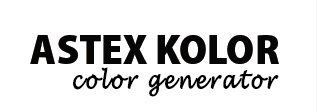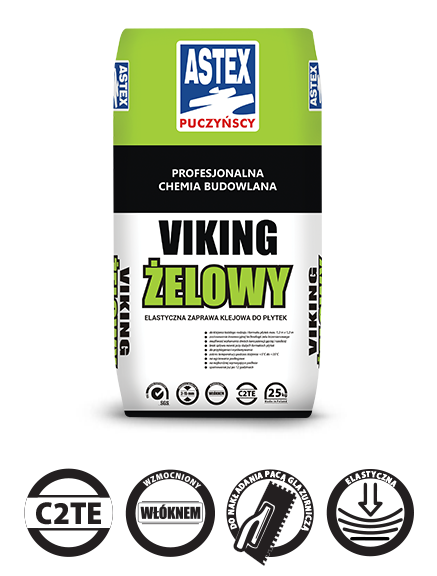Flexible gel adhesive mortar C2TE Viking Gel
Viking Gel is a flexible adhesive mortar in the C2TE class used for gluing ceramic tiles, natural stone, terracotta, stoneware, etc.
- For gluing all types and sizes of tiles max. 1200 mm x 1200 mm
- For underfloor heating
- No runoff
- Highly flexible
- The use of innovative silicate gel technology
- Possibility of making two dense and rare consistencies
- Temperature range when gluing: + 5 ° C to + 35 ° C

Calculate expenditure
Expenditure
4,0-5,0 kg/m²
Shell life
12 months from the date of production
Packaging
25 kg
Number of packages on a pallet
54 pcs
Properties
VIKING Gel is a ready-made, dry mixture based on high-quality cement and specially selected aggregates and silicate gel. The use of the additive allows you to adjust the consistency of the adhesive as needed without losing its parameters. It is characterized by good plasticity and adhesion to various types of building materials, which makes it a very versatile product. The mortar has been enriched with 6 mm long polypropylene microfibers, which create additional micro-reinforcement in the mortar. Special chemical modification eliminates the effect of sliding of a freshly adhered tile. VIKING Gel is a highly elastic, frost and waterproof product.
Substrate preparation
The substrate should be dry, stable, even and sound, i.e. strong enough, cleaned of layers that may weaken mortar adhesion (dust, dirt, lime, oil, fat, wax, oil and emulsion paint residues). Substrate unevenness greater than 15 mm, which prevents the application of the correct thickness of VIKING Gel adhesive mortar, should be corrected using materials recommended for this type of work. Excessive absorbency of the substrate should be reduced by using UNI-ASTEX priming emulsion. If it is necessary to glue tiles on solid substrates with a load capacity difficult to determine (e.g. dusty, difficult to clean), it is recommended to carry out an adhesion test consisting in sticking the tile and checking the connection after a minimum of 48 hours.
Mortar preparation
Pour the contents of the package into a measured amount of water (from 6l to 8.5 l / 25kg) and mix using a drill with a mixer until a homogeneous mass without lumps is obtained. Wait about 5 minutes and mix again. If necessary, add a small amount of water and mix again. Spread the mortar on the surface with a steel notched trowel. The substrate and ambient temperature during the work should be between + 5 ° C and +35 ° C. The consistency of Viking Gel adhesive mortar should be adjusted to the type of work performed by regulating the amount of mixing water. When gluing tiles on vertical surfaces, to exclude the effect of runoff, it is recommended to use the amount of water from the lower limit, i.e. about 6l / 25kg of mortar. Depending on the size of the tile format, when bonding on horizontal surfaces, the amount of mixing water can be increased to a maximum limit of 8.5 l / 25kg of mortar.
Do not soak tiles in water
Lay them on the mortar and press until the mortar sticks to your hands. Do not just lay the tiles! Keep the width of the joints depending on the tile size and operating conditions. Wash off fresh dirt with water and remove hardened dirt.
Application method
VIKING Gel adhesive mortar is used in the thin-layer method of tiling. It should be applied to the prepared surface with a steel notched trowel, and then evenly distributed and shaped (possibly in one direction). The mortar should not be applied once to a large surface, because after spreading the mortar retains its adhesive properties for about 30 minutes (depending on the parameters of the substrate and the environment). To check whether it is still possible to stick the tiles, it is recommended to carry out the test consisting in putting your hand on the previously applied mortar. If the glue remains on the fingers, then the tiles can be glued. When the fingers are clean, remove the old layer of adhesive and apply a new one. After spreading the mortar, lay the tile and press it thoroughly to the ground. The amount of mortar applied to the substrate should be selected so that after pressing the tile, the contact surface with the adhesive is evenly filled over the entire surface of the tile. The time to correct the position of the tile is up to 20 minutes from the moment it is pressed (depending on the parameters of the substrate and the environment). During the works, excess adhesive mortar that appears when pressing the tiles should be removed from the joints on an ongoing basis. Grouting the cladding can be started after hardening, after a period of 12 hours after gluing the tiles. The mortar achieves its functional strength within 3 - 4 days. In addition to the recommendations provided, work should be carried out in accordance with building practice and health and safety rules. The manufacturer guarantees the quality of the product, while it does not affect the conditions and the way it is used. If in doubt, carry out adhesion tests.
Temperature of performed work
Air temperature from + 5 ° C to +25 ° C. Substrate temperature from + 5 ° C to +25 ° C. Work in temperature between +5 ° C and +25 ° C. For a period of 7 days after the completion of works, the air temperature should not be below +5 ° C, and for the next 21 should not fall below 0 ° C.
Expenditure
Average consumption is 4.0-5.0 kg / m² on even surfaces. In practice, the consumption depends on the degree of evenness of the substrate and the type of tiles used.
Tools
Drill with a mixer, smooth and serrated steel float. Tools should be cleaned with clean water directly after use.
Storage and transport
The products must be absolutely stored in undamaged packaging and dry rooms on pallets. Protect against soaking, moisture during storage and transport. The storage period of the product in conditions complying with the recommendations given is up to 12 months from the date of production placed on the packaging in digital print. The date of production, which is placed on the packaging, is also the date of manufacture of the product. Any changes visible in the product or packaging structure without special tests, in particular discoloration or smudging of the packaging graphics, infringements of the packaging continuity, biological changes in the product structure, recognizable in particular as a consequence of moisture, may indicate poor storage or transport conditions and do not guarantee compliance declared product performance according to specifications.
Packaging
Paper bags: 25 kg
Precautions
Irritating product. Appropriate eye, respiratory and skin protection should be used. Keep away from children. Do not breathe in. In case of contact with eyes, rinse immediately with plenty of water and seek medical advice. If swallowed, seek medical advice immediately and show the packaging, label or Safety Data Sheet.
Technical data
Substrate temperature from + 5 ° C to + 35 ° C. Air temperature from + 5 ° C to + 35 ° C.
Caution
ASTEX- PUCZYŃSCY PLASTERS PAINTS guarantees and bears responsibility for the quality of the product, while it has no influence and is not responsible for the manner of use and conditions in which it was used. The recommendations and scope of use of the product or method of performance does not release the contractor from carrying out work in accordance with the principles of building art and health and safety regulations. If in doubt as to the use of the product, please contact us at Tel. 0 54 283 21 24 or by e-mail to the address: laboratory@astex-tynki.pl
Do you have questions? Doubts? Ask an advisor Contact form












